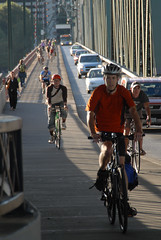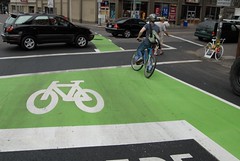“Results to date suggest that sidewalks and multi-use trails pose the highest risk… and the presence of bicycle facilities (e.g. on-road bike routes, on-road marked bike lanes, and off-road bike paths) was associated with the lowest risk.”
There’s a constant chorus — sometimes soft, sometimes overpoweringly loud — in every conversation about bike infrastructure in America. Its refrain: You’re safer without any bike lanes, separated lanes, cycle tracks, bike boulevards, off-road paths. Just take the lane, follow the rules, wear your helmet, and you’ll be fine.
A group of scholars at the University of British Columbia have found otherwise. They conducted a literature review, looking at all available studies linking bicycle safety with infrastructure. Their conclusions will be counterintuitive for some.
“Results to date suggest that sidewalks and multi-use trails pose the highest risk, major roads are more hazardous than minor roads, and the presence of bicycle facilities (e.g. on-road bike routes, on-road marked bike lanes, and off-road bike paths) was associated with the lowest risk.”
That’s right — riding on sidewalks and multi-use trails is less safe than riding on major roads. The studies surveyed found that riding on the sidewalk resulted in risks 1.8 to 16 times the risk of cycling on the road. One study found that sidewalk-riding crashes (the study’s authors purposefully do not use the word “accident”) exclusively occurred while riding against the flow of car traffic on the adjacent road.
The researchers also found that “street lighting [particularly on rural roads], paved surfaces, and low-angled grades are additional factors that appear to improve cyclist safety.”
These conclusions, the researchers are quick to note, are tentative, pending better data. They only found 23 English language studies that took on the relationship between bicycle safety and infrastructure, as opposed to a wealth of studies about helmets. They write,
“To date, most studies of cycling safety, especially in North America – have emphasized helmet design, regulation, and implementation to mitigate the severity of cycling injuries when a crash occurs.” But, they point out, helmets protect only from head injuries, and “more importantly, do not prevent incidents from occurring in the first place.”
“One of the major advantages of infrastructure-based improvements, compared to personal protective devices such as helmets, is that safe infrastructure provides population-wide protection for all cyclists,” study co-author Meghan Winters said in a press release.
The research on injuries and infrastructure that the researchers did uncover is often contradictory and does not use standardized (or even always decipherable) terms to identify different types of facility. There are deep problems with the reporting of data on cycling crashes and injuries.
What’s more, many types of infrastructure now common in North America have not been studied at all, including bike boxes, sharrows, and the relationship between cycling and speed bumps. (Some studies are in process — for instance, a bike box evalution is currently underway at the Institute for Bicycle and Pedestrian Innovation at PSU.)
The researchers have hopes that their review serves to point other scholars towards opportunities for filling in the many gaps in our knowledge of bicycle infrastructure and safety. As more studies are conducted, they say, there will be better data available to inform engineering guidelines to make bicycling safer and more appealing.



